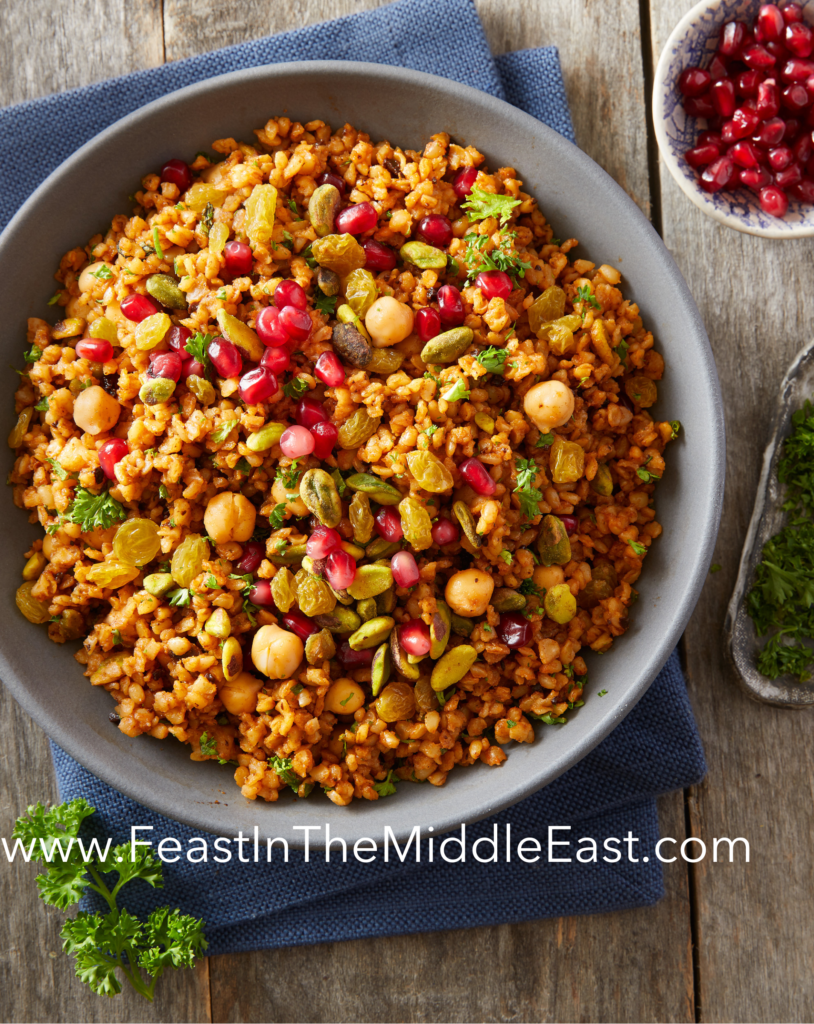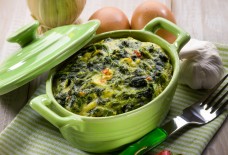Middle Eastern Pantry Staples to the Rescue With Hearty Bulgur Pilaf

By: Blanche Shaheen/Arab America Contributing Writer
Bulgur wheat holds a storied history in the Middle East, dating back thousands of years. Originating from ancient civilizations such as the Sumerians and Babylonians, bulgur was a staple due to its durability, quick cooking time, and versatility. Traditionally made by parboiling, drying, and cracking whole wheat grains, bulgur became integral to regional cuisines, from tabblouleh in Palestine to kibbeh in Lebanon. Nutritionally, bulgur is renowned for its high fiber content, aiding digestion and promoting satiety. It is also rich in minerals like manganese, magnesium, and iron, crucial for energy production and overall health. Low in fat and calories yet high in complex carbohydrates, bulgur provides sustained energy release, making it a valued component of balanced diets across the Middle East and beyond.
My pantry provided the inspiration for this colorful bulgur pilaf recipe. Turning wheat into bulgur is actually an ancient process. Arab civilizations record eating dried cooked wheat as early as 1,000 B.C. For people with little means, bulgur was an excellent food that could be stored for long periods of time and was filling and nutritious. As people from the Middle East migrated to the United States, bulgur came with them. There are 4 distinct sizes of bulgur, and for this recipe, I prefer #4, which is the largest sized grain. However you can use any size bulgur you want for this recipe, or even farro and barley as substitutes, which have a similar nutritional profile. Bulgur has a nutty flavor and chewy texture that absorbs seasoning very well, as well as offering a good dose of iron, folate, magnesium, protein, and fiber.
Pistachios and sultanas (golden raisins) are great pantry staples that you can use in this savory dish as well as for snacking on the side. Try buying some items like pomegranate molasses from middle eastern stores. Ethnic markets offer a treasure trove of pantry ingredients that can add excitement to your dishes even when you are sequestered at home. Pomegranate molasses has a long shelf life, adds antioxidants to your dishes, and is sweet, rich and tart. If you like to use garlic in your food, try buying black garlic from Asian markets. Black garlic has hints of caramel, with no pungency so you can add it to any dish without cooking it first. Black garlic is also non perishable, and can last months in your pantry with no need for refrigeration. Both the pomegranate molasses and the black garlic add a wealth of flavor to the dressing on this pilaf for very little cost.
Store bought ghee and chickpeas are other middle eastern pantry favorites that add non-perishable protein and fats to this dish. This particular pilaf is full of flavors and textures that are at once chewy, crunchy, nutty, sweet, and savory.
To see the technique of how to make this pilaf, click on the video below:
BULGUR PILAF
Ingredients:
1 cup bulgur #4 (largest variety)
1 tbsp butter or ghee
1 Shallot minced
1 ½ cup broth (either chicken or vegetable)
1 tsp cumin
1 tbsp tomato paste
1 tbsp dried or 1/2 cup fresh chopped parsley
1 tsp dried or ¼ cup fresh chopped mint
¼ cup feta cheese, crumbled
¼ cup sultanas (or you can use any other dried fruit you like)
¼ cup shelled, roasted, and salted pistachios
½ cup garbanzo beans (canned)
Salt and pepper to taste
Dressing
1 large bulb black garlic (or 1 tsp garlic powder)
1 tbsp pomegranate molasses
2 tbsp extra virgin olive oil
Heat butter in a saucepan, and add shallots. Saute until translucent. Add the bulgur wheat and incorporate with the shallots. Add the tomato paste, cumin, about ½ tsp salt and broth, and bring up the heat so the mixture could boil. Once boiling, reduce heat and cover, cooking for 20 minutes or according to package directions (finer bulgur wheat requires less time to cook). In the meantime, prepare the dressing. In a small food processor, add the black garlic (or garlic powder) along with the pomegranate molasses and olive oil. Whirl together. Once the bulgur is cooked, let cool until lukewarm temperature. Add the rest of the ingredients to the bulgur (from the pomegranate seeds to the garbanzo beans). Drizzle the pomegranate molasses dressing over the bulgur mixture and toss gently to combine. Season with salt and pepper to taste.
Blanche Shaheen is a journalist, host of the YouTube cooking show called Feast in the Middle East and cookbook author. For more authentic and classical Middle Eastern recipes, you can now purchase her brand new cookbook: “Feast in the Middle East, A Personal Journey of Family and Cuisine” by clicking Blanche Shaheen is the author of the cookbook called “Feast In the Middle East, a Journey of Family and Cuisine” which you can order here: https://secure.mybookorders.com/mbo_index.php?isbn=9781545675113 She is also a journalist, and host of the popular cooking show called Feast in the Middle East. She specializes in Arab cuisine of the Levant and beyond. You can check out her cooking video tutorials at https://www.youtube.com/user/blanchetv Her recipes can also be found at https://feastinthemiddleeast.wordpress.com/
Check out our Blog here!








